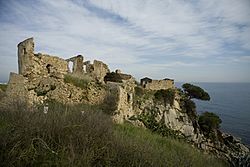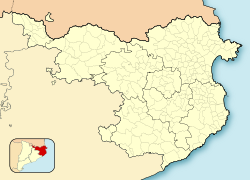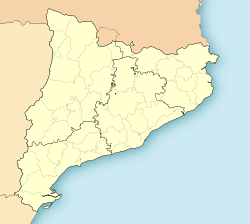Castell de Sant Esteve de Mar facts for kids
Quick facts for kids Castell de Sant Esteve de Mar |
|
|---|---|
| Near Palamós, Province of Girona in Spain | |

The castle of Sant Esteve
|
|
| Coordinates | 41°51′30″N 3°08′51″E / 41.8583°N 3.1475°E |
| Site information | |
| Open to the public |
No |
| Condition | Ruins |
The Castell de Sant Esteve de Mar is an old ruined castle. It stands on a cliff in the town of Palamós, in Baix Empordà, Spain. You can find it between La Fosca beach and Cala s'Alguer.
Today, only parts of its towers and walls are left. You can't go inside because it's fenced off. You can see it from a walking path (the GR 92) that goes from Fosca beach to S'Alguer.
Contents
History of the Castle
Ancient Times
Archaeologists found old Roman pottery, walls, and floors near the castle. They think a Roman villa (a large house) once stood there. This shows that people have lived on this spot since Roman times. It was probably a home for the Iberian people even before that.
Building a New Port
The castle was likely built in the 1100s. The first time it was written about was in the 1200s. Peter II of Barcelona (also known as Peter III of Aragon) needed a safe port for his royal ships. He wanted one along the coast between Barcelona and France.
In 1277, King Peter bought the castle and its land. He planned to build a new town and royal port there, which became Palamós. Once the new town and port were built, the castle became less important. By the 1300s, it was owned by a farmer. The land's name changed from "Sant Esteve castle" to "Palamós estate."
Watching the Seas
Later, the castle was used to watch the sea. It was part of a defense system against piracy and privateers (sailors who attacked ships for their country). In 1567, it stored gunpowder and had a small group of guards.
The castle kept its role in sea surveillance through the 1700s. But during that century, a farmhouse was built on top of the castle. People used the castle's old stones and structures to build the new house.
Modern Times
People lived in the farmhouse until the late 1800s. Around 1930, a Russian prince named Alexis M'Dvani bought the castle. He wanted to fix it up, but he passed away before he could.
Now, the castle property belongs to the Palamós City Council. The ruins have been made stronger and safer. This work was part of a project supported by a group called la Caixa.
See also
 In Spanish: Castillo de San Esteban de Mar para niños
In Spanish: Castillo de San Esteban de Mar para niños




